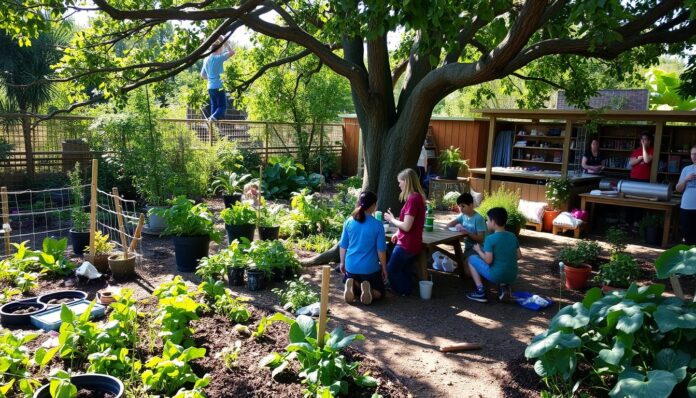The world is moving towards more sustainable ways, making permaculture education research key. It helps teach regenerative farming and sustainable agriculture. But, how can we make sure these programs are effective in teaching the next generation about the environment?
Permaculture education research looks into living sustainably, saving the environment, and building communities. It shows we need good ways to study permaculture education.
Permaculture Systems Design is all about caring for the earth, people, and sharing fairly. This is important in permaculture education research. It teaches us to think about the environment, society, and economy together.
By using permaculture in education, we can teach about building better societies. It helps us understand complex systems better.
Key Takeaways
- Permaculture education research focuses on sustainable living, environmental conservation, and community development.
- Effective research methods are necessary to evaluate and improve permaculture educational programs.
- Permaculture Systems Design emphasizes ethics centered on earth care, people care, and fair share.
- Permaculture education research can promote regenerative social structures and foster a deeper understanding of complex systems.
- Permaculture principles can be applied to educational design to promote sustainable agriculture education and regenerative farming practices.
- Permaculture education research can help address the disparity between productivity and financial yield in agricultural systems.
Introduction to Permaculture Education Research
Permaculture is a design system that aims to make ecosystems sustainable and regenerative. It focuses on three main ethics: caring for the earth, people, and sharing resources. In education, permaculture teaches ecological awareness and sustainable living.
Ecological design is a key part of permaculture education. It teaches students to design and manage ecosystems sustainably. Organic gardening lessons are also crucial, giving students hands-on experience in growing food and managing ecosystems.
By learning permaculture, students gain a deeper understanding of nature and their role in it. This knowledge can lead to a more sustainable future where humans live in harmony with the environment.
What is Permaculture?
Permaculture is a philosophy that aims to create positive change through holistic solutions. It views all living systems as interconnected. By working with nature, we can create sustainable ecosystems.
Permaculture emphasizes interacting with nature. It focuses on producing soil, food, community, and resilience.
Importance of Education in Permaculture
Education is vital in permaculture, as it teaches individuals to design and manage sustainable ecosystems. Educators teach permaculture principles and practices. This empowers students to make positive changes in their communities.
The benefits of permaculture education include:
- Promotes ecological awareness and sustainable living practices
- Provides hands-on experience in designing and managing ecosystems
- Empowers students to create positive change in their communities
- Supports the development of sustainable and regenerative ecosystems
By teaching permaculture, we can create a more sustainable future. Students learn to design and manage ecosystems. They also gain the power to make positive changes in their communities.
Overview of Research Methods in Education
Research methods in education are key to understanding how permaculture works in schools. Agroecology workshops and learning resources help develop these skills. They also promote sustainable practices. By using permaculture, teachers can make learning fun and interactive, helping students grasp ecological concepts better.
There are several research methods used in education. These include qualitative, quantitative, and mixed methods. These help evaluate permaculture programs and find ways to improve them. For instance, a study might use surveys and interviews to see how agroecology workshops affect students.
Qualitative vs. Quantitative Research
Qualitative research, like case studies and content analysis, dives deep into what students and teachers think. Quantitative methods, such as experiments and surveys, measure how well permaculture education works. By mixing these, researchers get a full picture of how permaculture education supports sustainable development.

Mixed Methods in Education Research
Mixed methods research combines qualitative and quantitative approaches. This is great for permaculture education research. It lets researchers understand both the effectiveness of programs and the experiences of students and teachers. This way, they can see how permaculture education leads to social change and sustainable development.
| Research Method | Description |
|---|---|
| Qualitative | Case studies, content analysis, interviews |
| Quantitative | Experiments, surveys, statistical analysis |
| Mixed Methods | Combination of qualitative and quantitative approaches |
Case Studies in Permaculture Education
Permaculture education is key to teaching sustainable farming. It helps people understand the value of regenerative farming practices and ecological design instruction. This knowledge inspires people to work together for a greener future.
In the U.S., studies show permaculture education works well. It helps farmers grow organic crops better. It also brings social, environmental, and economic gains.
- Show real examples of sustainable farming
- Encourage people to get involved and advocate
- Teach ecological design instruction and regenerative farming practices
By looking at these studies, we learn how vital sustainable agriculture education is. It plays a big part in creating a better future.
| Case Study | Location | Benefits |
|---|---|---|
| Permaculture Design Course | Nepal | Increased crop yields, improved soil health |
| Jajarkot Permaculture Programme | Nepal | Community training-based model, sustainable practices |
| Himalayan Permaculture Center | Nepal | Household and community training-based models, social benefits |
Surveys and Questionnaires
Surveys and questionnaires are key in permaculture education research. They help educators learn how well their permaculture teaching techniques and organic gardening lessons work. By looking at survey results, educators can spot what needs work and find better ways to teach environmental sustainability training.
A survey of 115 experienced permaculture educators showed interesting facts. Over 60% have taught for 6 or more years, with 38% teaching for over 10 years. Also, most course participants are women, making up 60% of the attendees.

The survey results show how crucial permaculture teaching techniques are for environmental sustainability training. Here’s a summary of the survey findings:
| Course Type | Effectiveness Rating |
|---|---|
| Diploma | 58% (very effective) |
| Permaculture Teacher Training | 56% (very effective) |
| Advanced Design/Professional Development | 56% (very effective) |
By using surveys and questionnaires, permaculture educators can make their organic gardening lessons and environmental sustainability training programs better. This helps in creating a more sustainable future.
Participatory Action Research (PAR)
Participatory Action Research (PAR) lets the community take an active role in research. It’s great for teaching permaculture and helping communities. People can work together to solve problems like food systems and saving the environment.
Agroecology workshops and learning resources are key for PAR. They help people learn the skills for sustainable projects. For example, a community might use permaculture to make a food system or learn organic farming in workshops.
Some benefits of PAR in permaculture education are:
- Community involvement and empowerment
- Social change and environmental conservation
- Development of sustainable projects and initiatives
By using permaculture and agroecology workshops in PAR, communities can make a difference.
| PAR Initiative | Permaculture Design Principles | Agroecology Workshops |
|---|---|---|
| Community food system | Apply permaculture design principles to create a sustainable food system | Participate in agroecology workshops to learn about organic farming practices |
| Environmental conservation | Use permaculture design principles to promote environmental conservation | Participate in agroecology workshops to learn about sustainable land management practices |
Ethnographic Research Methods
Understanding cultural contexts is key in permaculture education. It helps create programs that meet the needs of different communities. Methods like focus groups and semi-directed interviews offer insights into permaculture practitioners’ social dynamics and cultural backgrounds.
A study in southwest Michigan lasted sixteen months. It used interviews and observation to collect data. This showed how community networks and personal experiences shape permaculture practices.
Ethnographic research uncovers what motivates and challenges permaculture practitioners. It looks at the Knowledge-Practice-Belief (k-p-b) complex. This helps understand how knowledge is gained and used in sustainable practices.
This knowledge is vital for creating education programs. It supports ecological design and regenerative farming. This helps individuals and communities thrive.
Some important themes from ethnographic research in permaculture education are:
- Agency and Ethics
- Futurity and Empowerment
- Generosity and Sacred Economics
These themes show the need to consider the social and cultural aspects of permaculture. Sustainable agriculture education programs should focus on ecological design and regenerative farming.

Interviews in Permaculture Education Research
Interviews are key in permaculture education research. They offer deep insights into the views and experiences of those in the field. By using organic gardening lessons and environmental sustainability training, researchers can see what works best.
Choosing the right type of interview is crucial. You can pick between structured or unstructured interviews. Structured ones have set questions, while unstructured ones are more open. Mixing both can give you a lot of useful information.

To do great interviews, you need to prepare well. Listen carefully to what people say and be aware of your own biases. Make sure the setting is comfortable and the questions are open-ended. This way, you can get detailed data that helps improve permaculture education.
Curriculum Development and Assessment
Creating effective curricula in permaculture education is key. It involves using permaculture design principles to make learning fun and interactive. Agroecology workshops offer hands-on learning experiences for students. This helps students understand sustainable practices better.
Evaluating curriculum effectiveness is also vital. This can be done through project-based learning and the Kirkpatrick Four Levels of Evaluation. By doing this, educators can improve their teaching and student results. For example, project-based learning lets students solve real-world problems, deepening their grasp of permaculture.
- Alignment with academic standards
- Incorporation of experiential learning methods
- Evaluation of student outcomes using validated assessment tools
By focusing on these areas, educators can develop strong permaculture education programs. These programs prepare students for careers in sustainability and environmental education.
Online Platforms and Digital Tools
Online platforms and digital tools are key in teaching sustainable agriculture. They help spread the word about regenerative farming and ecological design. Thanks to digital media, anyone with internet can learn about permaculture.
Digital tools make research easier, cheaper, and more accessible. Online surveys, for example, can gather feedback from many people.
The benefits of using online tools in sustainable agriculture education include:
- More people can access information and resources.
- Learning online is convenient and affordable.
- It’s easier to reach and engage with different groups.
By using online platforms and tools, educators and researchers can help teach sustainable agriculture. This helps create a more environmentally friendly and sustainable food system.
Comparative Studies in Permaculture Education
Teaching permaculture is key for environmental training and organic gardening. By looking at different teaching models, we find the best ways to teach permaculture. A study on environmental sustainability shows the value of community and STEM education in permaculture.
Comparing permaculture education helps us see what works best. For instance, comparing programs in different places shows how setting and community affect success. Important things to look at include:
- Curriculum design and implementation
- Teaching methods and materials
- Student engagement and participation
- Assessment and evaluation methods
By studying these aspects, we learn what makes a good permaculture program. This knowledge helps us improve environmental training and organic gardening.
| Program | Location | Focus |
|---|---|---|
| Permaculture Living Lab | New York | Practical application of permaculture principles |
| Songhai, Benin | Benin | Sustainability and agriculture |
Community-Based Research Approaches
Community-based research is key in permaculture education. It lets researchers work with communities to bring about change. By using permaculture design principles, they create methods that focus on teamwork, watching, and talking.
Agroecology workshops and permaculture learning resources help a lot. They teach about green farming and how it affects local areas. For example, a project in the Mojave Desert, California, uses 2.5 acres for community projects. This shows how research can work with communities.
Engaging Communities in Research
Getting communities involved in research is vital. This can be done with participatory action research (PAR). It’s all about working together and learning from each other. This way, communities can lead research and make a difference.
Ethical Considerations in Community Research
Being ethical is crucial in community research. It means doing research the right way and with respect. Researchers must get consent, keep things private, and make sure it helps people and the planet. By working with communities, researchers can build trust and help create better futures.
- Apply permaculture design principles to research methodologies
- Utilize agroecology workshops and permaculture learning resources
- Prioritize community engagement and participation
- Ensure ethical considerations and responsible research practices
Impact of Technology on Permaculture Education Research
Technology is changing how we learn about permaculture. New tools help teach sustainable farming and ecological design. This makes learning more effective and efficient.
Emerging Technologies in Education
New tools like online platforms and digital tools are helping permaculture education. They make learning more accessible and flexible. They also help reach more people.
Evaluating Technology’s Effectiveness
It’s important to check if technology works well in permaculture education. We need to look at things like how valid and reliable it is. This means using strong research methods and good data.
Some interesting facts about technology in permaculture education include:
- Permaculture plots have three times more bird species compared to reference areas of conventional agriculture.
- Research identified three times more earthworms on permaculture areas than on conventional agricultural plots.
- There was a threefold increase in the number of plant species on permaculture farms compared to conventional agriculture.
Technology can improve learning in permaculture education. It helps teach sustainable farming and ecological design. By using new technologies and checking their effectiveness, we can make our food system better and more fair.
| Category | Permaculture | Conventional Agriculture |
|---|---|---|
| Bird Species | 3 times more | Reference area |
| Earthworms | 3 times more | Conventional agricultural plots |
| Plant Species | 3 times more | Conventional agriculture |
Challenges in Permaculture Education Research
Permaculture education research has big hurdles, like needing better scientific study and avoiding simple methods. Many people in permaculture stress the value of permaculture teaching techniques and organic gardening lessons. But, there’s a lack of resources and fear of experimental scrutiny that slows down progress.
Some big obstacles in permaculture education research include not having enough resources, social barriers, and not fully understanding permaculture. To tackle these, researchers and educators can use community-based research, participatory action research, and team learning.
By tackling these issues, permaculture education research can better support environmental sustainability training and organic gardening lessons. This can happen by deepening our grasp of permaculture and using more scientific research methods.
Future Directions in Permaculture Education Research
Looking ahead, we must focus on permaculture design principles for sustainable systems. These principles help us create new ways to practice agroecology. This includes agroecology workshops that teach practical skills and community involvement.
Creating permaculture learning resources is crucial. We need online courses, workshops, and community programs. These should teach permaculture design and its use in real life. This way, we can help people and communities build sustainable systems that work with nature.
- Creating new learning resources with the latest technology and teaching methods
- Expanding agroecology workshops to more communities for sustainable farming
- Studying how permaculture design works in different places and situations
By exploring these areas, we can grow the field of permaculture education. This will help us build a more sustainable world for everyone.
| Permaculture Design Principles | Agroecology Workshops | Permaculture Learning Resources |
|---|---|---|
| Observe and interact with nature | Practical skills training | Online courses and community programs |
| Catch and store energy | Community engagement and outreach | Workshops and hands-on training |
Conclusion
The field of sustainable agriculture education is full of research opportunities. It helps us understand regenerative farming and ecological design better. We’ve seen how different research methods, like case studies, offer insights into permaculture education.
Looking ahead, it’s important to keep exploring permaculture’s teaching potential. By working with communities and promoting STEM education, we can make a big difference. This way, we can prepare the next generation to care for our planet and create a better future.

